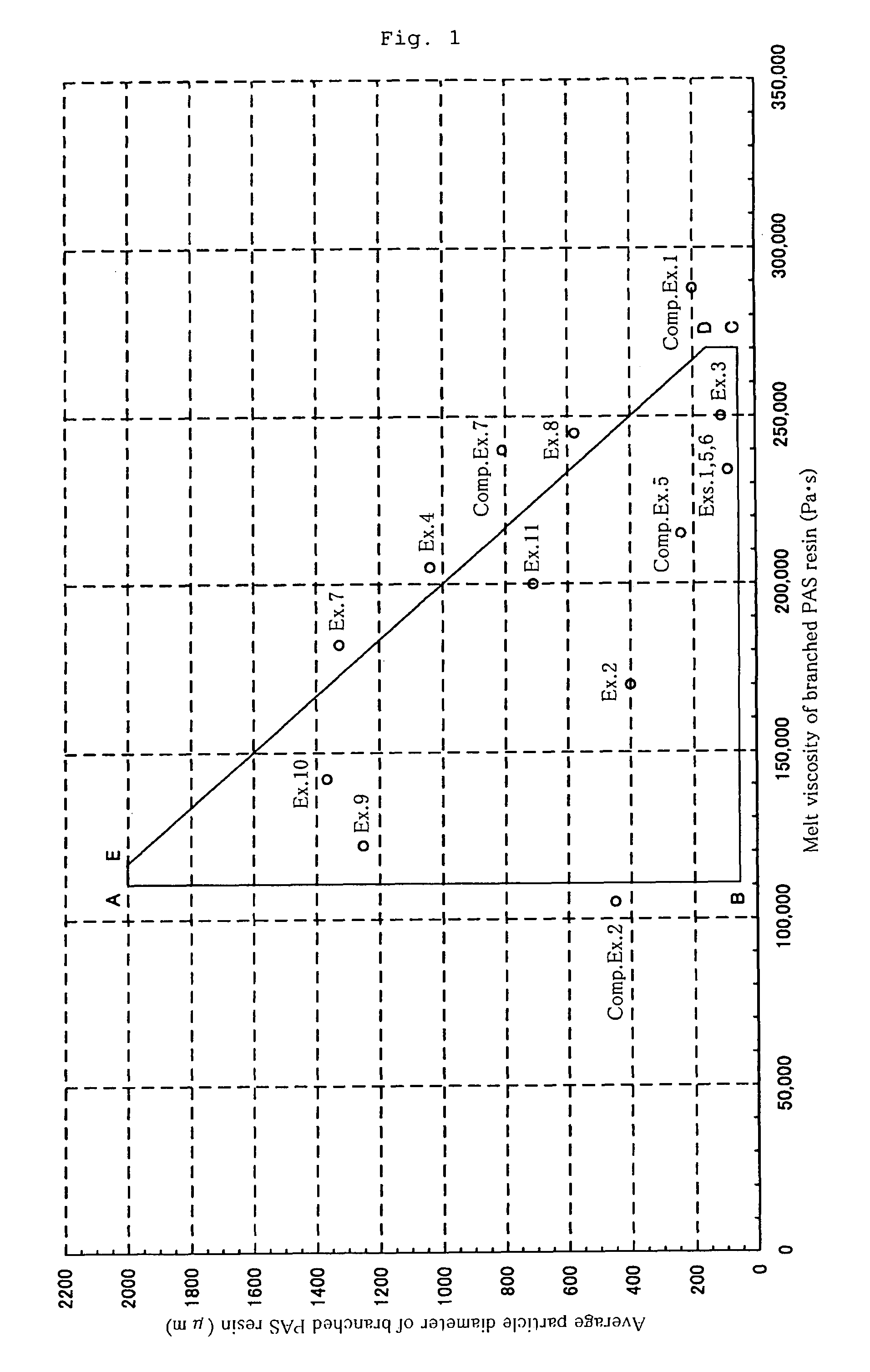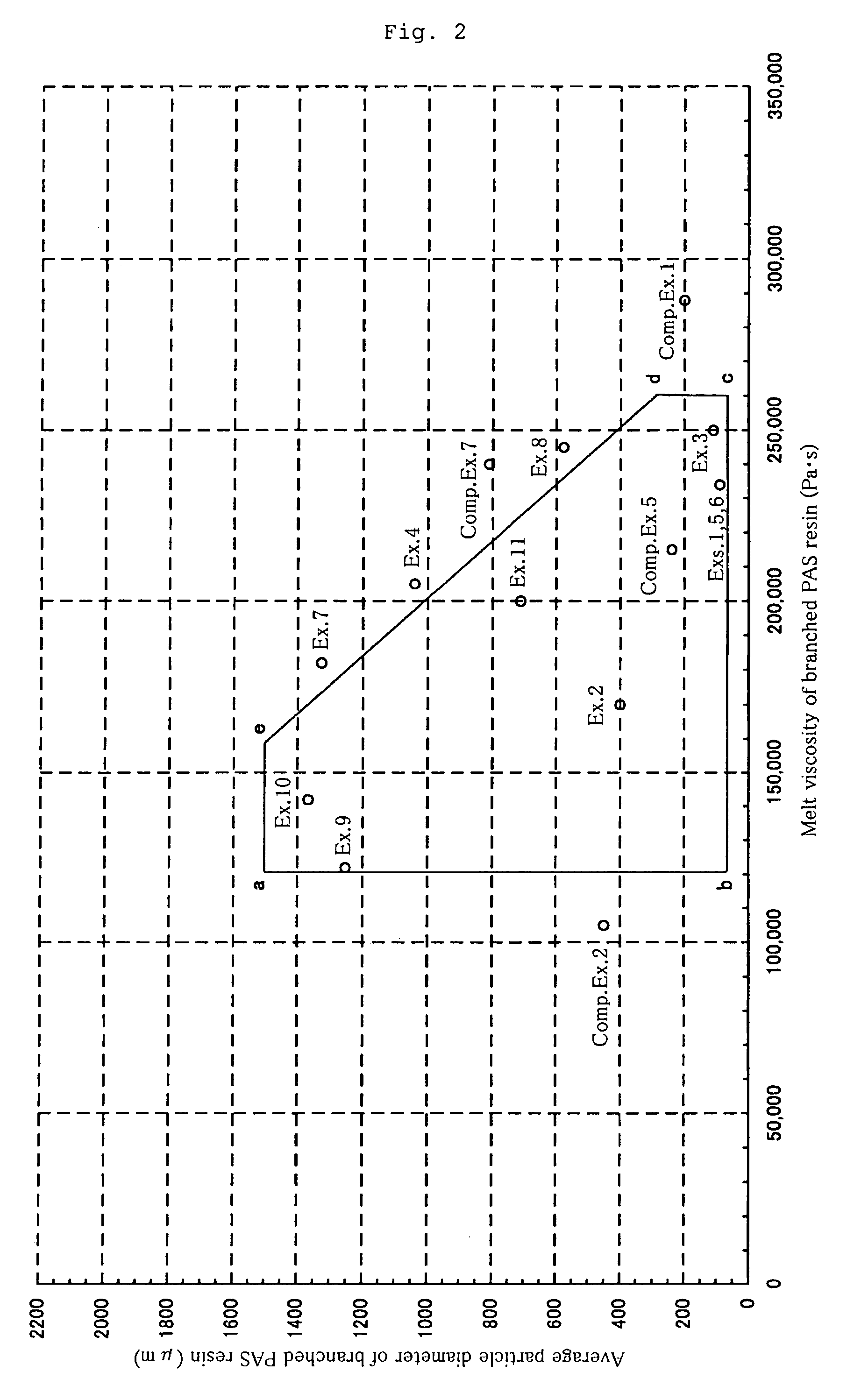Poly (arylene sulfide) resin composition and production process thereof
a technology of poly (arylene sulfide) and resin composition, which is applied in the direction of transportation and packaging, tyre parts, special tyres, etc., can solve the problems of insufficient resin composition, inability to precisely mold, and increased cost, and achieves excellent surface properties and little mold-corroding tendency
- Summary
- Abstract
- Description
- Claims
- Application Information
AI Technical Summary
Benefits of technology
Problems solved by technology
Method used
Image
Examples
synthesis example 1
Synthesis of Straight-Chain PAS Resin A1
(1) Dehydration Step
[0143]A 20-liter autoclave (reactor) made of titanium was charged with 1,951 g of an aqueous sodium hydrosulfide (NaSH) solution having an analytical value of 63.44% by weight as measured by iodimetry and 1,151 g (NaOH content: 21.52 mol) of a 74.78% by weight aqueous sodium hydroxide (NaOH) solution together with 6,701 g of N-methyl-2-pyrrolidone (hereinafter abbreviated as “NMP”).
[0144]The sulfur (S) content in 1,951 g of the aqueous sodium hydrosulfide (NaSH) solution is 22.08 mol. The analytical value of NaSH by a neutralization titration method in this aqueous solution is 61.86% by weight (21.53 mol), and 0.55 mol of sodium sulfide (Na2S) is contained therein. When a sulfur source composed of sodium hydrosulfide and sodium sulfide is indicated as “S”, NaOH / NaSH before dehydration is 1.00 (mol / mol), and NaOH / S is 0.97 (mol / mol).
[0145]After the interior of the reactor was purged with nitrogen gas, the contents were gradu...
synthesis example 2
Synthesis of Branched PAS Resin B1
(1) Dehydration Step
[0149]A 20-liter autoclave (reactor) made of titanium was charged with 1,801 g of an aqueous sodium hydrosulfide (NaSH) solution having an analytical value of 62.87% by weight as measured by iodimetry and 1,080 g (NaOH content: 20.08 mol) of a 74.40% by weight aqueous sodium hydroxide (NaOH) solution together with 6,000 g of NMP.
[0150]The sulfur (S) content in 1,801 g of the aqueous sodium hydrosulfide (NaSH) solution is 20.20 mol. The analytical value of NaSH by a neutralization titration method in this aqueous solution is 61.77% by weight (19.85 mol), and 0.35 mol of sodium sulfide (Na2S) is contained therein. When a sulfur source composed of sodium hydrosulfide and sodium sulfide is indicated as “S”, NaOH / NaSH before dehydration is 1.012 (mol / mol), and NaOH / S is 0.994 (mol / mol).
[0151]After the interior of the reactor was purged with nitrogen gas, the contents were gradually heated to 200° C. over 2 hours and 20 minutes with st...
synthesis example 3
Synthesis Of Branched PAS Resin B2
(1) Dehydration Step
[0155]A 20-liter autoclave (reactor) made of titanium was charged with 1,840 g of an aqueous sodium hydrosulfide (NaSH) solution having an analytical value of 62.39% by weight as measured by iodimetry and 1,094 g (NaOH content: 20.28 mol) of a 74.16% by weight aqueous sodium hydroxide (NaOH) solution together with 6,005 g of NMP.
[0156]The sulfur (S) content in 1,840 g of the aqueous sodium hydrosulfide (NaSH) solution is 20.48 mol. The analytical value of NaSH by a neutralization titration method in this aqueous solution is 61.09% by weight (20.05 mol), and 0.43 mol of sodium sulfide (Na2S) is contained therein. When a sulfur source composed of sodium hydrosulfide and sodium sulfide is indicated as “S”, NaOH / NaSH before dehydration is 1.011 (mol / mol), and NaOH / S is 0.990 (mol / mol).
[0157]After the interior of the reactor was purged with nitrogen gas, the contents were gradually heated to 200° C. over 2 hours with stirring to disti...
PUM
| Property | Measurement | Unit |
|---|---|---|
| temperature | aaaaa | aaaaa |
| melt viscosity | aaaaa | aaaaa |
| temperature | aaaaa | aaaaa |
Abstract
Description
Claims
Application Information
 Login to View More
Login to View More - R&D
- Intellectual Property
- Life Sciences
- Materials
- Tech Scout
- Unparalleled Data Quality
- Higher Quality Content
- 60% Fewer Hallucinations
Browse by: Latest US Patents, China's latest patents, Technical Efficacy Thesaurus, Application Domain, Technology Topic, Popular Technical Reports.
© 2025 PatSnap. All rights reserved.Legal|Privacy policy|Modern Slavery Act Transparency Statement|Sitemap|About US| Contact US: help@patsnap.com


